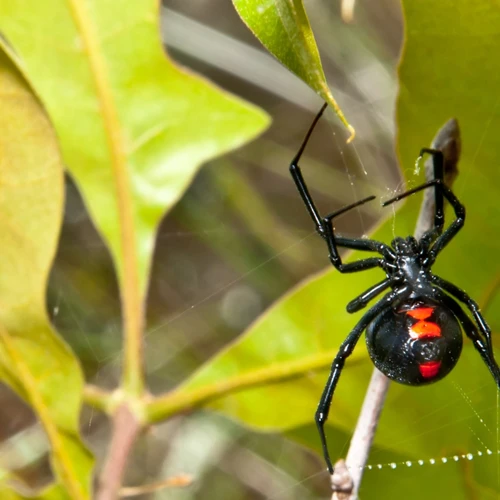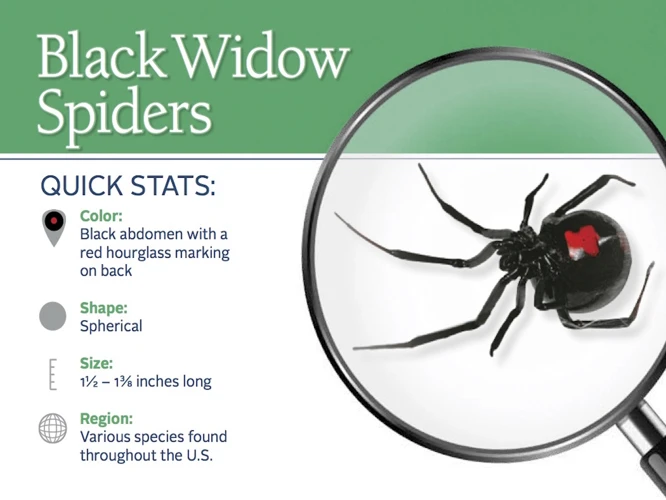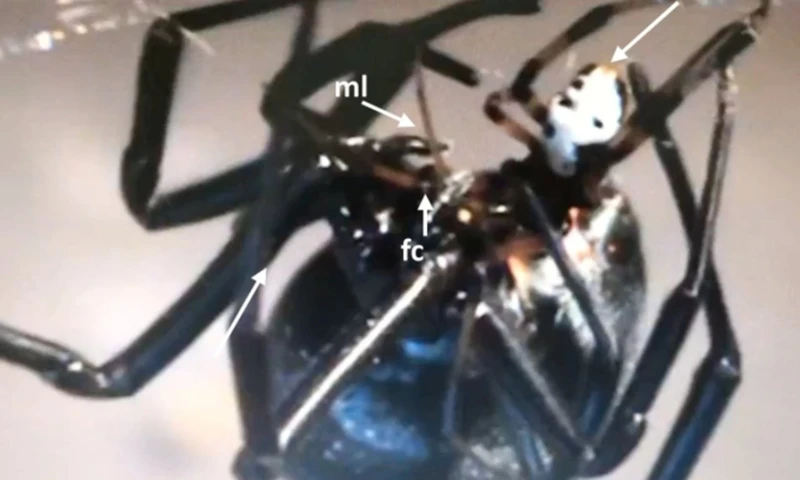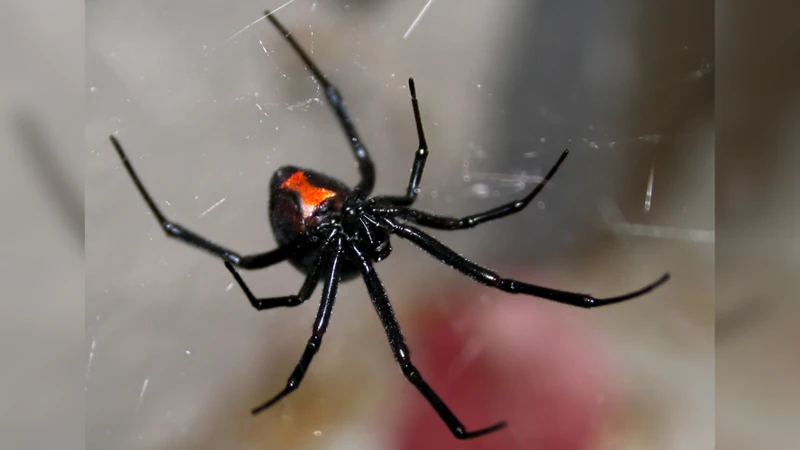As nature’s enigmatic creatures, female black widow spiders have captured the attention and curiosity of researchers and enthusiasts alike. Their striking appearance and infamous reputation as a deadly arachnid species have made them a subject of fascination for many. However, it is their reproductive behavior that sets them apart from any other spider species. In this article, we delve into the mysterious world of the female black widow spider and explore the intricacies of their unique reproductive behavior. From sexual cannibalism to the egg-laying process, we outline everything you need to know about these fascinating creatures. So, put on your arachnologist hat, and let’s explore the captivating world of female black widow spiders.
What is Black Widow Spider?

The black widow spider, scientifically known as latrodectus mactans, is one of the most well-known and feared arachnids in the world. This spider is easily recognizable by its sleek black body, shiny appearance and distinctive red hourglass marking on the underside of the abdomen. Black widows can be found throughout the southern and western United States, as well as in parts of South America. Despite their fearsome reputation, black widows are actually quite shy and only bite humans in self-defense, making them more of a danger to insects and other small prey.
Sexual dimorphism is pronounced in black widow spiders, with females being nearly double the size of males, up to 1.5 inches in body length. Females can be identified by their shiny black bodies with a bright red hourglass-shaped marking on the underside of the abdomen. Males, on the other hand, are smaller in size and have a unique appearance that makes them easy to distinguish from females. They have a light brown color with white markings and red or orange spots on their backs.
Black widow spiders have a unique reproductive behavior that sets them apart from other species of spiders. Female black widows are particularly well-known for their tendency to cannibalize their mates during or after mating, although this is not always the case. After mating with a male, the female typically lays about 200 eggs in a silken sac, which she guards until they hatch in about a month. The spiderlings emerge from the sac and immediately begin to disperse, and undergo several molts before reaching adulthood.
Female black widows play a critical role in ensuring the continuation of their species by producing fertile eggs. The temperature and humidity of the environment both play a crucial role in the reproductive process of black widows. These factors can influence egg production and the success rate of the egg-laying process.
Understanding the biology and behavior of black widow spiders is important for anyone who lives in an area where these spiders are common. Knowing how to identify a black widow, its habitat, and its behavior is essential to staying safe from these venomous spiders. For more information about the reproductive behavior of female black widow spiders, check out the Evol Adv Sex Cannib Black Widow Spiders article.
Facts about Female Black Widow Spiders

Black widow spiders are one of the most feared creatures in the world. Their venomous bite has been known to cause severe pain and even death in some cases. However, there is more to these spiders, especially the females, than just their venomous bite. In this section, we will explore some intriguing facts about female Black Widow Spiders that you may not have known. From their distinctive bodies to their unique reproductive behaviors, these spiders have many traits that make them fascinating creatures. So, let’s dive into the world of female Black Widow Spiders and learn more about their interesting characteristics.
Female Black Widow Spiders’ Bodies
Female black widow spiders are well-known for their distinctive appearance. They are identified by their shiny black color and a characteristic red hourglass-shaped marking on their abdomen. Female black widows have a bulbous body that is about the size of a grape, while males are significantly smaller.
Here are some important features of female black widow spider’s bodies:
- Female black widow spiders’ bodies are dark and shiny.
- They have eight legs and are arachnids.
- Female black widow spiders have a bulbous abdomen, which is where their reproductive organs are located.
- The red hourglass-shaped marking on their abdomen identifies them as female black widows.
- Black widow spiders have a cephalothorax, which is where their eyes are located.
- Female black widow spiders have chelicerae that contain venom glands.
Understanding the anatomy of female black widow spiders is crucial in identifying and avoiding them. It’s important to note that female black widow spiders are venomous and their bites can be harmful to humans. Knowing how to identify them can be helpful in avoiding dangerous encounters.
For more information on the reproductive behavior of black widow spiders, check out this article or this one to learn about their mating frequency.
Female Black Widow Spiders’ Diet and Habitat
Female black widow spiders are carnivorous and prey on a variety of insects, including mosquitoes, flies, grasshoppers, beetles, and caterpillars. They are also known to feed on other spiders and even small vertebrates such as lizards and mice. Their diet, however, depends on their habitat. Black widow spiders are mainly found in warm, dry, and undisturbed areas, including woodlands, forests, deserts, and fields. They often build webs in dark corners, under rocks, and in crevices to catch their prey.
Table: Diet and Habitat of Female Black Widow Spiders
| Habitat | Prey |
|---|---|
| Woodlands | Beetles, caterpillars, and other insects |
| Forests | Mosquitoes, flies, and other insects |
| Deserts | Scorpions, centipedes, and other insects |
| Fields | Grasshoppers, crickets, and other insects |
Female black widow spiders are adaptable to different environments, and their diet may vary depending on the availability of prey in their habitat. They use their venomous bites to subdue their prey before wrapping them in silk and feeding on them. In case you want to know more about silk in reproduction, follow the link.
The Reproductive Behavior of Female Black Widow Spiders

The reproductive behavior of female black widow spiders is a topic of both intrigue and fear. Female black widow spiders are known for their deadly venom and for their unique reproductive behaviors. They are fascinating creatures, with their distinctive markings and intricate web designs. In this section, we will delve into the world of female black widow spiders and explore their mating rituals, pregnancies, and egg-laying processes. We will also discuss why female black widow spiders are famous for their reproductive behavior and how to stay safe from them. Let’s explore the fascinating world of the black widow spider and learn all about their reproductive behavior.
Mating
During mating, the female black widow spider plays an active role, while the male plays a somewhat passive role. The male typically initiates the mating process by approaching the female and tapping her web to announce his presence. Once the female determines that the male is a suitable mate, she may start the mating process.
A crucial characteristic of black widow spider mating is sexual dimorphism. According to research, sexually mature female black widows are always larger than males. The difference in size is so significant that it can sometimes lead to sexual cannibalism when males attempt to mate.
During mating, the male black widow cautiously approaches the female, often backing away or retreating multiple times during the process. Whenever the male gets close enough to the female, he deposits sperm onto a web that he has spun. Then, he uses his palps to collect the sperm and insert it into the female.
An interesting fact about black widow spider mating is that males insert one or both of their palps, which are small appendages near their mouth, into the female’s reproductive opening during intercourse. The palps then release the sperm into the female’s spermathecae.
Mating in black widow spiders is usually a short process, often lasting only a few seconds or minutes. After mating, the male black widow spider usually runs away as quickly as possible to avoid being cannibalized by the female.
It’s worth noting that black widow spiders mate throughout their lifespan, but females may become less fertile as they age.
| Male Role | Female Role |
|---|---|
| Initiates mating by tapping female’s web | Determines if male is suitable mate |
| Deposits sperm onto web | Receives and stores sperm from male |
| Inserts sperm using palps | May initiate or accept sperm from male |
| Cannibalizes male after mating in some cases | |
| Mates throughout lifespan | |
Sexual dimorphism in black widows is one of the fascinating aspects of their mating behavior. However, it’s essential to note that while some aspects of black widow spider mating are interesting, it’s crucial to avoid these spiders to prevent significant health issues.
Sexual Cannibalism
Sexual cannibalism is a well-known aspect of the female black widow spider’s reproductive behavior. This phenomenon refers to the female’s tendency to devour the male after mating. The exact reasons for this behavior are still under debate among scientists, but it is believed that it could be a means of providing extra nutrition to the female to aid in offspring development or simply to eliminate competition for resources.
During the mating process, the male spider approaches the female and initiates courtship behavior. If the female is receptive, the two spiders will mate, with the male transferring sperm to the female’s reproductive organs. However, immediately after or even during copulation, the female may turn on the male and kill and eat him.
It is interesting to note that not all female black widow spiders practice sexual cannibalism, and it seems to be more common in captive environments than in the wild. This could be due to factors such as stress, lack of prey, or other environmental conditions.
One theory about why the female black widow spider practices sexual cannibalism is that it helps to ensure the survival of her offspring. By consuming the male, she gains an additional source of nutrients that could help her produce stronger offspring. Additionally, females that consume their male partners may have a higher chance of producing more offspring, as they will not have to compete with the male for resources.
While sexual cannibalism may seem like a gruesome and unnecessary behavior, it is a natural part of the female black widow spider’s reproductive strategy. It is also important to note that male spiders have evolved ways to avoid being eaten, such as approaching the female slowly and carefully or leaving quickly after mating.
If you want to learn more about the mating habits of male black widow spiders, check out our article on How Male Black Widow Spiders Mate and What Happens After.
Pregnancy
During pregnancy, female black widow spiders often become much more aggressive than usual and guard their egg sacs fiercely. The duration of the pregnancy period, also known as the gestation period, ranges from 10 to 14 days, during which the female spider constructs a silken cocoon and deposits her eggs inside. Typically, a female black widow spider can lay anywhere from 100 to 400 eggs at once.
The primary factor that influences the success of the black widow spider’s pregnancy is the temperature and humidity. If the temperature and humidity aren’t optimal, the eggs can fail to hatch or develop properly. For example, if the temperature is too low, the eggs may not hatch, and if it’s too high, the spiderlings can die. The ideal temperature for the development of the black widow spider’s eggs is between 27°C and 32°C. The humidity should range between 70 to 80 percent for proper egg development.
The environmental factors are essential for the survival of the black widow spiderlings. After the spiderlings hatch, they have a high risk of predation and need to disperse rapidly to find suitable living conditions. Female black widow spiders have evolved to lay their egg sacs in hidden, safe places to help protect their offspring from predators. The black widow spiderlings hatch from the eggs after about 12 days of the incubation period and moult several times before leaving the egg sac to disperse.
A successful pregnancy is crucial for the survival of the black widow spider species. The temperature, humidity, and the location where the eggs are laid play vital roles in the survival of the eggs, and any fluctuation in the environmental factors can affect the survival of the spiderlings. If a female black widow spider successfully makes it through the pregnancy and her spiderlings hatch and disperse, the chances of the survival of her offspring increase significantly. You can read more about the hatching process of black widow spiderlings at black-widow-spiderlings-hatching.
Egg-Laying Process
During the egg-laying process, a female black widow spider can produce up to 9 sacs filled with anywhere from 20 to 900 eggs each. The number of eggs depends on various factors including temperature, humidity, and the environment. While laying the eggs, female spiders spin a web around the sacs and guard them fiercely, as they are highly vulnerable to predators.
The egg-laying process takes around 30 minutes per sac, and a female spider will lay one sac every few days. Once the sacs are laid, it takes between 20 and 30 days for the eggs to hatch. During this time, the temperature and humidity of their environment plays a critical role in the survival of the offspring.
According to research, the ideal temperature range for black widow spider egg incubation is between 70 and 90 degrees Fahrenheit. At temperatures above or below this range, the eggs may not hatch or the spiderlings may not survive. Proper humidity levels are also crucial, and the environment must be kept moist.
When the spiderlings emerge from the eggs, they are born with their first set of legs and are fully capable of hunting for food. However, they will stay close to their mother for several days feeding on her regurgitated food until they are strong enough to hunt on their own.
The egg-laying process of female black widow spiders is a remarkable feat of nature, and it demonstrates their commitment to ensuring the survival of their offspring. However, it’s important to note that their sacs can be a danger to humans, so it’s best to observe these creatures from a safe distance.
Why Female Black Widow Spiders are Famous for Their Reproductive Behavior

Female black widow spiders are known for their unique reproductive behavior that has attracted the attention of many scientists and nature enthusiasts. The spider’s method of sexual cannibalism, in which the female spider kills and eats the male spider after copulation, has made it famous. This behavior has also been observed in various species of mantises and other spiders, but the black widow spider is the most well-known species for this behavior. Researchers and scientists are perplexed about why this behavior exists in black widow spiders, but several theories have been proposed.
One theory suggests that this behavior may have evolved as a result of environmental factors such as food availability and climate. Research conducted on environmental factors affecting black widow spider reproduction has shown that cannibalism may allow the female to gain extra nutrients necessary for producing and caring for her young. This behavior may also help to limit the number of males in a given area, reducing competition for resources and increasing the chances of their own offspring’s survival.
Another theory suggests that this behavior may be a form of sexual selection. This theory posits that female black widow spiders choose males who are most likely to provide good genes for her offspring. The act of mating itself may be seen as a test of the male’s fitness, while the act of cannibalizing him after mating may be seen as a sign of his inability to provide good genes. This, in turn, can lead to the selection of the fittest males.
Beyond the reproductive behavior, black widow spiders are also known for their long lifespan and unique mating process. Female black widow spiders can live up to three years in the wild, which is much longer than most other spider species. The male spider, on the other hand, has a much shorter lifespan and often dies after mating.
The reproductive behavior of female black widow spiders is unique and fascinating. While researchers are still unsure of the exact reason behind this behavior, theories suggest that it may be linked to environmental factors or sexual selection. Studying these spiders can give us insights into the evolution of reproductive behaviors, and help us better understand the natural world around us. It’s important to remember that while these spiders can be dangerous, they play a vital role in maintaining the delicate balance of ecosystems. If you encounter a black widow spider, it’s best to observe it from a safe distance and respect its place in the natural world.
How to Stay Safe from Female Black Widow Spiders
When it comes to staying safe from female black widow spiders, prevention is key. One of the best ways to avoid encounters with these venomous spiders is to keep your living space clean and organized. This means regularly vacuuming, sweeping, and dusting areas where spiders may hide, such as dark corners, basements, and crawl spaces.
It’s also important to take precautions when spending time outdoors, especially in areas where black widows are known to thrive. When hiking or camping in wooded areas, wear long sleeves and pants to avoid spider bites. Additionally, try to avoid sticking your hands into crevices or holes where spiders may be hiding.
If you do come across a female black widow spider, remember to stay calm and avoid provoking the spider. Back away slowly and give the spider plenty of space to avoid any accidental bites. If you do get bitten, seek medical attention immediately to avoid any potentially dangerous complications.
It’s also important to be aware of black widow egg sacs, which can contain hundreds of spiderlings. If you come across an egg sac, do not touch it and call a professional pest control service to safely remove it. For more information on female black widow spiders’ eggs, check out our dedicated article.
By taking these simple precautions and staying informed about the behavior of female black widow spiders, you can minimize the risk of encountering these venomous arachnids and stay safe in your living space and outdoor adventures.
Conclusion
In conclusion, the reproductive behavior of female black widow spiders is fascinating yet dangerous. These creatures exhibit unique behaviors when it comes to mating, sexual cannibalism, pregnancy, and egg-laying. Female black widows are known for their venomous bites and their preference for preying on their mates. However, it’s important to note that they only bite when threatened or provoked.
Despite the dangers associated with these spiders, it’s still important to appreciate their role in the ecosystem. As predators, female black widows help control populations of insects and other small creatures. If you have a black widow infestation near your home, it’s best to contact a professional exterminator rather than attempting to remove them yourself.
To stay safe from female black widow spiders, avoid dark and cluttered areas where they may be hiding, always wear gloves and protective clothing when handling outdoor items, and inspect any outdoor equipment before use. Additionally, it’s important to seek medical attention immediately if you suspect you have been bitten by a black widow spider.
In conclusion, while female black widow spiders may have a fearsome reputation, they are a vital part of the ecosystem and should be treated with respect. By understanding their behaviors and taking appropriate precautions, we can coexist with these creatures in a safe and respectful manner.
Frequently Asked Questions
1. How venomous are Female Black Widow Spiders?
Female Black Widow Spiders are considered highly venomous, and their bite can be extremely painful and potentially lethal to humans. However, fatalities are rare due to the availability of antivenom.
2. What do Female Black Widow Spiders eat?
Female Black Widow Spiders feed on insects, other spiders, and sometimes even small vertebrates. They inject their prey with venom, which immobilizes it and breaks down its tissues, making it easier to consume.
3. Why are Female Black Widow Spiders called “widows”?
Female Black Widow Spiders are called “widows” because they have a tendency to cannibalize their mates after mating, leaving the male dead. This behavior gives them a widow-like reputation.
4. Are all Female Black Widow Spiders black?
No, not all Female Black Widow Spiders are black. Some can have a reddish-brown or dark brown coloring. However, most species of Black Widow Spiders have a distinctive red hourglass shape on their abdomen.
5. How long do Female Black Widow Spiders live?
Female Black Widow Spiders can live for up to three years in the wild.
6. How often do Female Black Widow Spiders mate?
Female Black Widow Spiders typically mate only once in their lifetime. However, they can store sperm from one mating and use it to fertilize their eggs throughout their lifespan.
7. How many eggs do Female Black Widow Spiders lay?
Female Black Widow Spiders can lay anywhere from 100 to 1000 eggs per oviposition (egg-laying) event.
8. Do Female Black Widow Spiders build webs?
Yes, Female Black Widow Spiders build webs, which they use as a means of catching prey and for protection.
9. Can Female Black Widow Spiders be kept as pets?
While some people do keep Black Widow Spiders as pets, it is not recommended due to their venomous nature and potential danger to humans.
10. What should I do if I am bitten by a Female Black Widow Spider?
If you are bitten by a Female Black Widow Spider, seek medical attention immediately. Symptoms can vary, but typically include severe pain, muscle cramping, and sometimes nausea and vomiting.







